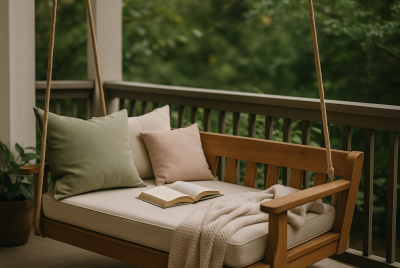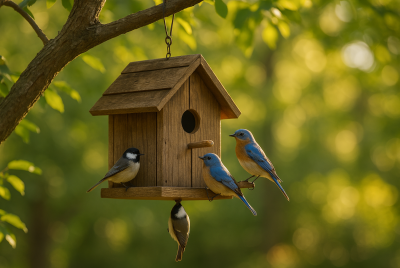Swing Set for Kids: Safety Tips & Setup
We may earn a commission for purchases made using our links. Please see our disclosure to learn more.
You’re here because you want a swing set for kids that’s safe, fun, and actually fits your space (and your budget). Maybe you’re picturing weekend giggles, chalk-dusted hands, and that “one more push!” soundtrack. In this guide, we’ll walk through safety, sizing, materials, installation, upkeep—and yes, trusted product picks—so you can buy with confidence and set it up right the first time.
What Makes a Great Swing Set for Kids?
A great set balances safety, durability, and play value. You want sturdy materials, pinch-guard chains, age-appropriate swings, and enough activities (slide! rock wall! saucer!) to keep play fresh without turning your yard into a theme park.
Quick checklist
- Stable A-frame or anchored base
- Chain covers or coated chains
- Clear use zones (front/back of swings)
- Weather-resistant materials (cedar/steel/HDPE)
- Manufacturer weight/age guidelines you’ll actually follow
Safety First (And Always)
Think of safety as layers: good gear, smart setup, and ongoing checks. Choose a model that lists weight limits, uses coated chains, and avoids sharp edges. Then add impact-absorbing surfacing beneath and around it (more on that below). Teach simple rules (“one at a time on the slide,” “clear the landing zone”) and revisit them each season as kids grow.
Space Planning: Will It Fit Your Yard?
Grab a tape measure and sketch your yard to scale. Most families underestimate use zones—you need space in front and behind each swing and enough clearance around slides and ladders.
Rule of thumb
- Add at least 6 feet (1.8 m) of clear space around equipment.
- Keep the swing arc away from fences, steps, and hardscapes.
- For small yards, consider single-bay or portable frames and swap accessories seasonally.

The Right Surface Under a Swing Set
Grass looks soft, but it compresses into hard ground. Safer options include engineered wood fiber, wood chips, sand, pea gravel, or unitary rubber surfaces—installed to the depths recommended for the equipment’s fall height. Keep these materials raked and topped up; they compress over time, especially in high-traffic swing paths.
Materials: Wood vs. Metal vs. HDPE
Each has a personality:
- Cedar/Redwood (wooden swing set): Warm, classic look, naturally rot-resistant. Needs sealing and periodic checks for splinters.
- Powder-coated steel (metal swing set): Very durable, low maintenance; great for humid or rainy climates.
- HDPE + steel frames: Weather-proof, easy-clean surfaces with fewer splinters/snag points; often the lowest maintenance.
Age & Stage: Matching the Set to Your Kids
- Toddlers (9–36 months): Bucket seats with harness; low platforms; gentle slides.
- Preschool (3–5): Belt swings, small rock walls, 6–8 ft slides.
- Ages 6–10: Higher swings, wavy slides, monkey bars, trapeze.
- Tweens: Heavy-duty frames, saucer/web swings, taller decks (with strict rules).
Must-Have Safety Features
- Coated or sheathed chains to prevent pinches
- Anchoring hardware or a free-standing design tested for stability
- No-gap hardware and rounded caps on exposed ends
- Clear labeling for age/weight limits
- Guardrails on decks and barrier walls near slide entries
Setup: DIY or Pro Install?
You can DIY many sets with two adults, a weekend, and a ratchet set. Pro install is worth it if your yard slopes, soil is rocky, or you’re short on time. If you DIY, layout first, then pre-sort hardware into labeled containers—future you will thank past you.

Budgeting: Where to Spend vs. Save
- Spend on: frame strength, surfacing, and corrosion resistance.
- Save on: extra accessories you can add later (binoculars, steering wheels, chalkboard panels).
- Tip: A budget swing set with excellent surfacing is safer than a premium frame on hard ground.
Seasonal Maintenance (Fast, Not Fussy)
- Spring: Tighten bolts, check chain wear, re-rake/top up surfacing.
- Mid-summer: Quick hardware check; wipe mildew or sap.
- Fall: Seal wood (if applicable); store fabric seats in harsh winters.
- After storms: Inspect anchors and ground shift.
Inclusivity & Play Value
If you’ve got a wide age range—or kids with different sensory preferences—mix it up: belt swing + bucket swing + saucer/web swing for shared play. Consider shaded canopies, quiet “perch” areas, and ground-level activities (sandbox, chalk panel) for kids who like slower transitions.
Small Yard Solutions
Look for single-bay A-frames, compact clubhouse-plus-slide footprints, or portable toddler swings that attach to a pergola or existing frame. A space-saving swing set with one slide and one swing bay can still deliver big smiles.
Troubleshooting Common Issues
- Squeaks → Light silicone on metal-to-metal joints (avoid chains).
- Seat pinches → Replace with coated chains; check S-hooks.
- Wobbly posts → Re-square and re-anchor; check for ground heave after heavy rains.
- Uneven surfacing → Rake back into swing troughs weekly.
Picks & Comparisons: 5 Amazon Favorites
Below are five well-loved models covering different needs, yard sizes, and budgets. I’ve summarized features, pros/cons, who it’s for, and a quick read on common reviews.
1) Backyard Discovery Buckley Hill Cedar Wood Swing Set
Small-yard friendly cedar set with a compact deck, wave slide, rock wall ladder, and two belt swings—classic look without a huge footprint.
Features: Cedar frame, wave slide, mini rock wall, canopy.
Pros: Warm wood aesthetic; good starter height for younger kids.
Cons: Deck height and slide are shorter for older kids.
Best for: Tight spaces; ages ~3–8.
Review snapshot: Families praise the value and fit for small yards; some note assembly takes time.
2) Gorilla Playsets Avalon Wooden Swing Set
Premium cedar playset with dual wave slides, rock wall, sandbox space, and accessories—one of those “neighborhood magnet” builds.
Features: Dual slides, rock wall + rope, sandbox area, steering wheel, canopy roof.
Pros: Lots of activities; solid cedar construction.
Cons: Larger footprint; assembly is an all-day project.
Best for: Multi-kid households; ages ~4–10.
Review snapshot: Praised for sturdy build and variety; occasional comments about time-intensive assembly.
3) Lifetime Monkey Bar Adventure (Model 91028)
Powder-coated steel frame with monkey bars, 9′ wavy slide, trapeze bar, and three belt swings; a durable alternative to wood.
Features: Steel frame, coated chains, wavy slide, monkey bars, trapeze.
Pros: Low maintenance; weather-resistant; free-standing designs available in the Lifetime lineup.
Cons: Heavier to move once assembled; industrial look vs. cedar style.
Best for: Humid climates; older kids who love monkey bars.
Review snapshot: Users like the stability and longevity; occasional notes about anchoring and weight.
4) Sportspower My First Metal Swing Set with Slide
A value-forward metal swing set with two belt swings, a trapeze, and a slide—great entry point for younger kids.
Features: Two swings, trapeze, 5 ft slide, adjustable chains.
Pros: Budget-friendly; straightforward assembly.
Cons: Lower weight limits than premium sets; kids may outgrow sooner.
Best for: Ages ~3–7; starter backyard setups.
Review snapshot: Families love the price-to-fun ratio; some mention lighter feel vs. heavy-duty models.
5) Step2 Infant to Toddler Swing (Seat)
A toddler bucket swing with harness for ages 9–36 months; attach to an existing frame for safe early swinging.
Features: High-back bucket design, harness, weather-resistant rope.
Pros: Secure fit for littles; easy to install.
Cons: Limited to toddler years.
Best for: Babies/toddlers; families upgrading a current frame.
Review snapshot: Loved for security and ease; some wish for softer straps.
Comparison Table (At-a-Glance)
| Model | Key Spec(s) | Warranty* | Approx Price/Tier | Best For |
| Backyard Discovery Buckley Hill | Cedar frame, wave slide, compact deck | Limited (see listing) | $ – $$ | Small yards / ages 3–8 |
| Gorilla Playsets Avalon | Dual slides, rock wall + rope, sandbox | Limited (see listing) | $$ – $$$ | Multi-kid play / ages 4–10 |
| Lifetime Monkey Bar Adventure (91028) | Powder-coated steel, 9′ slide, monkey bars | Limited (see listing) | $$ – $$$ | Low maintenance / ages 5–12 |
| Sportspower My First | Metal frame, 2 swings + trapeze + slide | Limited (see listing) | $ | Budget starter / ages 3–7 |
| Step2 Infant to Toddler Swing | Bucket seat with harness | Limited (see listing) | $ | Toddlers 9–36 months |
*Always confirm warranty on the product page.

How to Choose (Without Second-Guessing Yourself)
Ask yourself:
- What ages and how many kids will use this in the next 3–4 years?
- Where will it sit, and do you have clearance for swing arcs and slide exits?
- Are you willing to seal wood or do you want low-maintenance steel/HDPE?
- What budget tier feels comfortable including surfacing?
Install & Anchor Like a Pro
- Layout first with stakes/strings.
- Square the frame before tightening.
- If anchoring, use manufacturer hardware and torque to spec.
- Finish by checking chain height so toes don’t drag and seats don’t ram the ground on big arcs.
Research-Backed: Why Surfacing + Active Play Matter
Two credible sources consistently highlight what keeps kids safer and healthier outdoors:
- The U.S. Consumer Product Safety Commission’s Public Playground Safety Handbook (2025) explains that falls are the leading hazard and outlines protective surfacing materials and depths to reduce head-injury risk. If you install loose-fill (like wood chips), plan for compression over time and regular top-ups to maintain protection. Read the guidance in the CPSC handbook.
- The CDC’s 2025 Outdoor Play & Safety resource underscores that regular outdoor activity supports developmental milestones and overall health, and even notes benefits like potential reductions in nearsightedness with time spent in bright daylight. See the CDC overview on outdoor play and safety.
(Bottom line: pair an age-appropriate frame with proper surfacing and frequent play—that’s the safest, healthiest combo.)
Accessorize for Longevity (and Fewer “I’m Bored” Moments)
Rotate in a saucer swing for group play, add a chalkboard panel under the deck for shade-time creativity, and keep a storage tote of outdoor balls/ropes nearby. Small tweaks extend the life of your setup without expanding the footprint.
FAQs
Is a wooden or metal swing set better for humid climates?
If you prefer lower maintenance, powder-coated steel (or HDPE + steel) resists rot and splinters. If you love the look of cedar, plan on seasonal sealing and regular inspections.
How deep should playground surfacing be under a swing set?
Depth depends on fall height and material. As a general principle, install to the manufacturer/CPSC guidelines and top up regularly because loose-fill compresses with use. (See the CPSC handbook in the Research section.)
What’s the safest swing for toddlers?
A bucket-style seat with a harness (ages ~9–36 months) mounted to a stable frame at the correct chain length—always with active supervision.
How often should I tighten hardware and inspect the set?
Do a quick visual check monthly and a deeper bolt/chain check each season—plus after major storms or freeze-thaw cycles.
Is it required to anchor the swing set?
Many sets recommend anchoring for tip resistance. If you’re on soil, follow the included anchoring kit specs; for free-standing steel models designed without anchors, confirm weight/footing guidance in the manual.
Wrap-Up: You’ve Got This
A safe, joyful swing set for kids comes down to three things: the right frame for your ages and yard, impact-absorbing surfacing you maintain, and simple, consistent rules. Start with a solid base, add features over time, and keep the setup tuned as your kids grow. When you’re ready to style the surrounding play nook, these treehouse décor ideas can spark fun finishing touches in your yard. (See cozy treehouse décor inspiration on The Treehouse Nest.)




